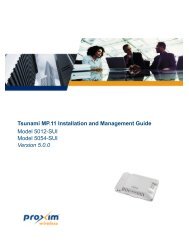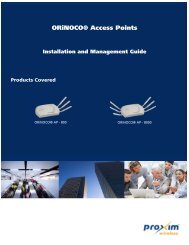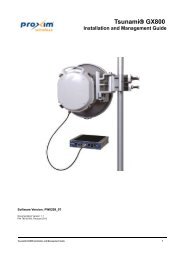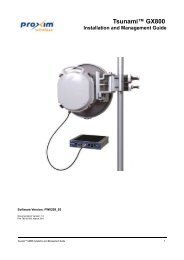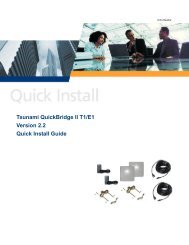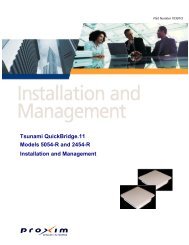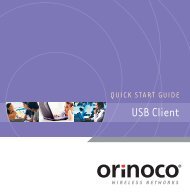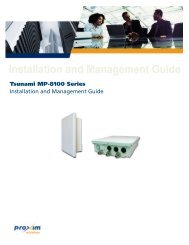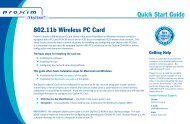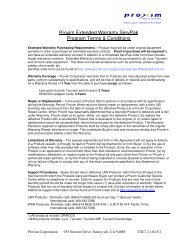Tsunami MP.11 Installation and Management Model 5012-SUR ...
Tsunami MP.11 Installation and Management Model 5012-SUR ...
Tsunami MP.11 Installation and Management Model 5012-SUR ...
You also want an ePaper? Increase the reach of your titles
YUMPU automatically turns print PDFs into web optimized ePapers that Google loves.
Configuration <strong>Tsunami</strong> <strong>MP.11</strong> <strong>5012</strong>-<strong>SUR</strong> <strong>Installation</strong> <strong>and</strong> <strong>Management</strong><br />
Network Parameters<br />
NOTE: To enable roaming, you must enable Roaming Status on both the BSU <strong>and</strong> the SU.<br />
An SU scans all available channels for a given b<strong>and</strong>width during roaming. In order to reduce the number of channels an<br />
SU has to scan <strong>and</strong> thus decrease the roaming time, a channel priority list that tells the SU what channels to scan is<br />
implemented. Each channel in the channel priority list is specified with its corresponding b<strong>and</strong>width <strong>and</strong> the priority with<br />
which it should be scanned, either “Active” (st<strong>and</strong>ard priority), “Active High” (high priority), or “Inactive”.<br />
An SU will scan all channels indicated as “Active” during roaming. However, it will scan active channels indicated as<br />
“High Priority” before scanning active channels indicated as st<strong>and</strong>ard priority. Channels that are not going to be used in<br />
the wireless network should be configured as “Inactive” so that the SU can skip over those channels during scanning<br />
saving this way time.<br />
A BSU broadcasts the channel priority list to all valid authenticated SUs in its sector. It re-broadcasts the channel priority<br />
list to all SUs every time the list is updated on the BSU. For information for configuring the channel priority list on the BSU<br />
see the <strong>Tsunami</strong> <strong>MP.11</strong>-R <strong>Installation</strong> <strong>and</strong> <strong>Management</strong> Guide.<br />
Note that an SU may roam from one BSU with a b<strong>and</strong>width setting to another BSU with a different b<strong>and</strong>width setting.<br />
Since in this case more channels need to be scanned than with only one channel b<strong>and</strong>width setting, it is important that<br />
the channel priority list is properly used to limit scanning time.<br />
When Scanning Across B<strong>and</strong>width on the SU is enabled (see Interface Parameters), the SU supports b<strong>and</strong>width<br />
selection of the communications channel of either 20 MHz, 10 MHz, or 5 MHz, as available. This allows the BSUs in the<br />
network to be set to different b<strong>and</strong>widths while an SU can still roam from one BSU to the next, because it will not only<br />
scan other frequencies (when the signal level or quality are lower than the threshold) but it will also switch to other<br />
b<strong>and</strong>widths to find a BSU that may be on another b<strong>and</strong>width than its current one.<br />
During roaming, the SU will start scanning first the channels on its current b<strong>and</strong>width from the “Active” channel list<br />
provided by the BSU in order to find a BSU to register, since that is the most likely setting for other BSUs in the network.<br />
If the SU cannot find an acceptable roaming c<strong>and</strong>idate, it will switch b<strong>and</strong>width <strong>and</strong> start scanning channels on that<br />
corresponding b<strong>and</strong>width from the “Active” channel list provided by the BSU. The process is repeated until the SU finds<br />
an appropriate BSU to register.<br />
In the example above, an SU whose current b<strong>and</strong>width is 20 MHz will start scanning all active channels within the<br />
b<strong>and</strong>width of 20 MHz. If it cannot find a suitable BSU, it will switch to a 10 MHz b<strong>and</strong>width <strong>and</strong> start scanning all active<br />
channels within that b<strong>and</strong>width, in this case channel 56 first since it is configured as high priority <strong>and</strong> channel 60 next. No<br />
channels will be scanned on the 5 MHz b<strong>and</strong>width since all those channels are configured as inactive.<br />
DHCP Server<br />
When enabled, the DHCP server allows allocation of IP addresses to hosts on the Ethernet side of the SU or BSU (or) to<br />
the connected SU's (in case, the DHCP server is enabled in BSU). Specifically, the DHCP Server feature lets the SU or<br />
BSU respond to DHCP requests from Ethernet hosts/connected SU's (in case, the DHCP server is enabled in BSU) with<br />
the following information:<br />
• Host IP address<br />
• Gateway IP address<br />
64






